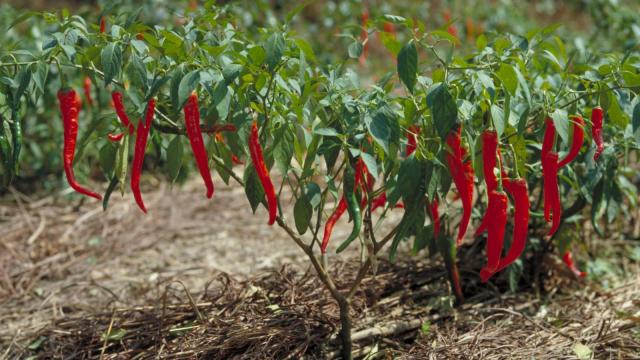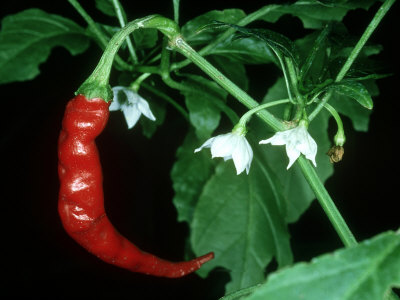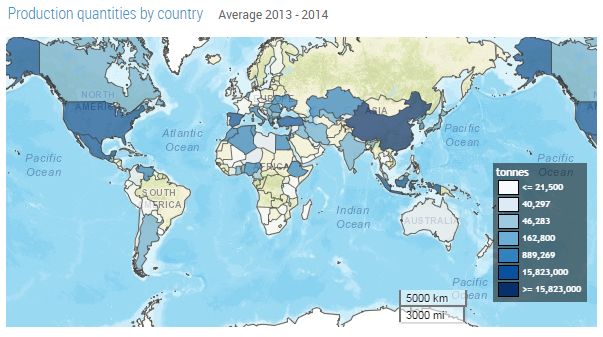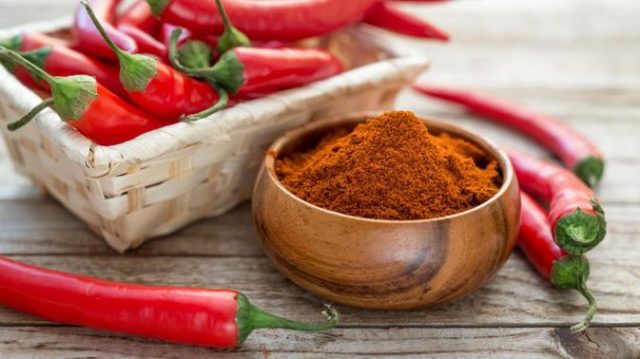
Cayenne plant with both green and red peppers
General Information (The School of Natural Healing 2004)
Cayenne peppers start out green but turn red, orange, or yellow when ripe, they are long and skinny in shape. They grow on annual shrub-type plants that can get up to 4 feet tall and have little white flowers. The peppers are hot and pungent and are eaten fresh, cooked, and dried. Because of their strong flavor, they were named from the Greek work kaptos, which means “I bite.” The dried and crushed peppers are used as a spice in many different foods and especially in Cajun, Creole, Southeast Asian, Chinese, Southern Italian, and Mexican cooking. Cayenne is the base for the popular Tabasco Sauce found in many grocery stores and restaurants. It is also used for medicinal purposes. The heat and medicinal properties are mostly due to the chemical, capsaicin, that they contain.

Cayenne pepper and flowers
Cayenne originated in Central and South America, with the oldest known specimen being from Mexico. It was first cultivated between 5200 and 3400 BC. From the Americas, it was spread into Europe by a companion of Columbus, and from there was spread to Asia and Africa. It is currently cultivated across much of the world.

Traditional Uses (Ehrlich 2015)
The Peruvian Indians included cayenne in almost all their food and claimed that it comforted the stomach.
In traditional Indian Ayurvedic, Chinese, Japanese, and Korean medicines, Cayenne pepper has been taken orally to help with stomach problems, poor appetite, and circulatory problems. It was also applied to the skin for arthritis and muscle pain.
In Greece, Italy and parts of Russia, it was steeped in vodka and taken orally as a folk medicine cure-all tonic.
In the West Indies it was used against deadly fevers, including yellow fever.
It is currently put into ointments and creams that are applied topically to reduce pain from arthritis and shingles.

Cayenne, dried and ground into powder for culinary and medicinal use
Medicinal Properties (Ehrlich 2015)
The most active chemical medicinally in cayenne peppers is capsaicin, though they also include vitamin A, vitamin C, flavonoids, carotenoids, and pigments with antioxidant properties.
Capsaicin relieves pain when applied to the skin. It does this by reducing the amount of the substance P, which is a chemical that carries pain signals to the brain. Without substance P, though the skin is experiencing pain, it can’t communicate that with the brain so it goes consciously unnoticed. Because of this property, cayenne pepper is often recommended to be applied topically in creams to help with arthritis (Deal et al. 1991), joint and muscle pain, shingles, pain after surgery, and pain from nerve damage in the feet and legs from diabetes (Capsaicin study group 1991). It can also reduce the itching and swelling from the skin disease, psoriasis. These uses are very similar to the traditional uses of cayenne pepper and are confirmed in the scientific literature as being effective.
Cayenne pepper can be eaten raw, cooked, or dried. It is also available in capsule and cream form. The cream should not be applied to cracked skin or open wounds and should be kept away from the eyes and nose. Also, it does not dissolve easily in water, so if it is irritating the skin it should be removed with vinegar.

Capsaicin, the most medicinally active component of cayenne peppers
Current Research
Research is being done on the possibility of taking cayenne orally to help reduce blood sugar levels. One study looked at energy metabolism in Japanese women after eating meals either with or without cayenne pepper. They found that the women eating food with cayenne pepper had an increase in diet-induced thermogenesis, which means that they had a greater increase in metabolic rate (Yoshioka et al. 1998). This increase in metabolic rate may lower blood sugar levels.
Another group of scientists hypothesized that Type 1 diabetes is caused by a malfunctioning of pain nerves that surround cells in the pancreas. This causes the pancreas to fail in producing enough insulin to level out blood sugar levels. They injected capsaicin into mice with Type 1 diabetes and found that the mice started producing insulin. The capsaicin cured diabetes in the mice and the cure lasted for up to several months after only one injection (Razavi et al. 2006).
There has also been research on using orally delivered capsaicin to reduce physical fatigue and improve exercise performance. One group of researcher found that capsaicin did just that when administered to mice for four weeks. They hypothesized that the results were due to capsaicin improving mitochondrial biogenesis and ATP production (Hsu et al. 2016).
Sources
Deal C L, Schnitzer T J, Lipstein E, Seibold J R, Stevens R M, Levy M D, Albert D, Renold F. (1991) Treatment of arthritis with topical capsaicin: a double-blind trial. Clinical Therapeutics 13(3): 383-395
Ehrlich S D. (2015) Cayenne. University of Maryland Medical Center. http://www.umm.edu/health/medical/altmed/herb/cayenne
Hsu, Y J, Huang, W. C., Chiu, C. C., Liu, Y. L., Chiu, W. C., Chiu, C. H., … Huang, C. C. (2016). Capsaicin Supplementation Reduces Physical Fatigue and Improves Exercise Performance in Mice. Nutrients, 8(10), 648.
Razavi R, Chan Y, Afifiyan N A, Liu X J, Wan X, Yantha J, Tsui H, Tang L, Tsai S, Santamaria P, Driver J P, Serreze D. (2006) TRPV1+ sensory neurons control beta cell stress and islet inflammation in autoimmune diabetes. Cell 127(6): 1097-1099
The Capsaicin Study Group. (1991) Treatment of painful diabetic neuropathy with topical capsaicin. A multicenter, double-blind, vehicle-controlled study. Arch Intern Med. 151:2225-9.
The School of Natural Healing (2004) A history of the healing chili. Dr. Christopher’s Herbal Legacy http://www.herballegacy.com/Cayenne_History.html
Yoshioka M, St-Pierre S, Suzuki M, Tremblay A. (1998) Effects of red pepper added to high-fat and high-carbohydrate meals on energy metabolism and substrate utilization in Japanese women. Br J Nutr. 80(6):503-510.
Image Sources
http://www.asiaseeds.com/product/cayenne-long-red-pepper/
https://www.pinterest.com/pin/129548926751552325/
https://upload.wikimedia.org/wikipedia/commons/3/3a/Pepper_production_map_FAOSTAT_2014.png
http://www.livestrong.com/article/413288-cayenne-pepper-and-inflammation/
